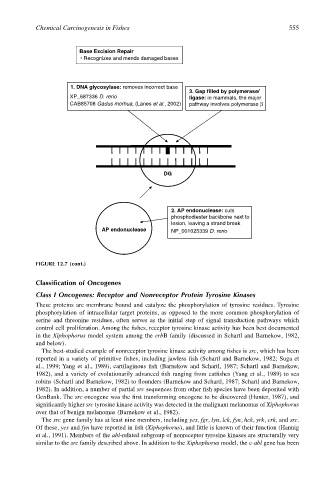Page 575 - The Toxicology of Fishes
P. 575
Chemical Carcinogenesis in Fishes 555
Base Excision Repair
• Recognizes and mends damaged bases
1. DNA glycosylase: removes incorrect base
3. Gap filled by polymerase/
XP_687336 D. rerio ligase: in mammals, the major
CAB85708 Gadus morhua, (Lanes et al., 2002) pathway involves polymerase β
DG
2. AP endonuclease: cuts
phosphodiester backbone next to
lesion, leaving a strand break
AP endonuclease NP_001025339 D. rerio
FIGURE 12.7 (cont.)
Classification of Oncogenes
Class I Oncogenes: Receptor and Nonreceptor Protein Tyrosine Kinases
These proteins are membrane bound and catalyze the phosphorylation of tyrosine residues. Tyrosine
phosphorylation of intracellular target proteins, as opposed to the more common phosphorylation of
serine and threonine residues, often serves as the initial step of signal transduction pathways which
control cell proliferation. Among the fishes, receptor tyrosine kinase activity has been best documented
in the Xiphophorus model system among the erbB family (discussed in Schartl and Barnekow, 1982,
and below).
The best-studied example of nonreceptor tyrosine kinase activity among fishes is src, which has been
reported in a variety of primitive fishes, including jawless fish (Schartl and Barnekow, 1982; Suga et
al., 1999; Yang et al., 1989), cartilaginous fish (Barnekow and Schartl, 1987; Schartl and Barnekow,
1982), and a variety of evolutionarily advanced fish ranging from catfishes (Yang et al., 1989) to sea
robins (Schartl and Barnekow, 1982) to flounders (Barnekow and Schartl, 1987; Schartl and Barnekow,
1982). In addition, a number of partial src sequences from other fish species have been deposited with
GenBank. The src oncogene was the first transforming oncogene to be discovered (Hunter, 1987), and
significantly higher src tyrosine kinase activity was detected in the malignant melanomas of Xiphophorus
over that of benign melanomas (Barnekow et al., 1982).
The src gene family has at least nine members, including yes, fgr, lyn, lck, fyn, hck, yrk, crk, and src.
Of these, yes and fyn have reported in fish (Xiphophorus), and little is known of their function (Hannig
et al., 1991). Members of the abl-related subgroup of nonreceptor tyrosine kinases are structurally very
similar to the src family described above. In addition to the Xiphophorus model, the c-abl gene has been

